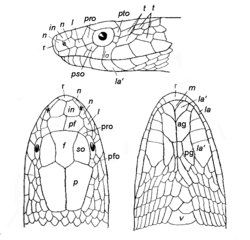Biology:Madagascarophis lolo
| Madagascarophis lolo | |
|---|---|
| Scientific classification | |
| Domain: | Eukaryota |
| Kingdom: | Animalia |
| Phylum: | Chordata |
| Class: | Reptilia |
| Order: | Squamata |
| Suborder: | Serpentes |
| Family: | Pseudoxyrhophiidae |
| Genus: | Madagascarophis |
| Species: | M. lolo
|
| Binomial name | |
| Madagascarophis lolo | |
Madagascarophis lolo is a species of snakes known for being endemic to the African area of Madagascar .[1][2] The creature is colloquially referred to as the ghost snake due to its strikingly pale body shade.[3][4] It was initially found inside of a lime rock formation in 2016.[5][6]
Description
Madagascarophis lolo can be identified from other species in its genus by its gray, overall body color with black vertebral stripe and dorsal, alternating lighter gray splotches. It has 25 midbody scale rows, 189 ventral scales and 56 divided subcaudal scales. With the exception of M. fuchsi, it differs from all other Madagascarophis species by having extended contact of posterior infralabial scales. M. lolo can be distinguished from M. fuchsi by its slightly lower number of infralabial scales, with M. lolo having around 10 infralabial scales to the approximately 12–13 infralabial scales of M. fuchsi.[7][1]
Behavior
Alike other species of Madagascarophis, M. lolo is nocturnal.[7]
Habitat
Their habitat is variable, as they are terrestrial and semi-arboreal, but mainly are found on karst rock formations. Researchers propose that the rarity of M. lolo sightings could be due to their rough terrain habitat, as the karst rock formations are difficult to navigate, especially in the night, when M. lolo would be active.[7]
Distribution
Madagascarophis lolo is probably endemic to karst areas of Analamerana and Ankarana of Madagascar.[7]
Etymology
Madagascarophis lolo gets its specific name lolo from the Malagasy word for "ghost". There are two reasons for this name, namely, the pale gray color of the ghost snake, and the elusiveness of the species relative to other species in an area of Ankarana that is relatively well explored.[7]
See also
- Wildlife of Madagascar
References
- ↑ 1.0 1.1 Madagascarophis lolo at the Reptarium.cz Reptile Database. Accessed 19 June 2017.
- ↑ "Madagascarophis lolo: New Species of Cat-Eyed Snake Discovered in Madagascar | Biology | Sci-News.com" (in en-US). http://www.sci-news.com/biology/madagascarophis-lolo-ghost-snake-madagascar-04163.html.
- ↑ "'Ghost snake' discovered in Madagascar". https://www.sciencedaily.com/releases/2016/09/160902142207.htm.
- ↑ "'Ghost snake' species discovered in Madagascar" (in en-IN). The Hindu. 2016-09-04. ISSN 0971-751X. http://www.thehindu.com/news/international/ghost-snake-species-discovered-in-madagascar/article9072216.ece.
- ↑ NatureWorldNews (2016-09-04). "Rare Discovery: Lolo the 'Ghost' Snake Found in a Lime Rock Formation in Madagascar". http://www.natureworldnews.com/articles/28088/20160904/ghostly-slither-lolo-the-ghost-snake-discoverd-in-lime-rock-formation-in-madagascar.htm.
- ↑ Supernova, Periwinkle (2016-09-05). "'Ghost' Snake New Species Discovered In Madagascar Rock Formation - News Independent" (in en-US). http://www.thenewsindependent.com/ghost-snake-new-species-discovered-madagascar-rock-formation/15851/.
- ↑ 7.0 7.1 7.2 7.3 7.4 Ruane, Sara; Burbrink, Frank T.; Randriamahatantsoa, Bernard; Raxworthy, Christopher J. (2016). "The cat-eyed snakes of Madagascar: Phylogeny and description of a new species of Madagascarophis (Serpentes: Lamprophiidae) from the Tsingy of Ankarana" (in en). Copeia 104 (3): 712–721. doi:10.1643/ch-15-346.
Wikidata ☰ Q28431921 entry



